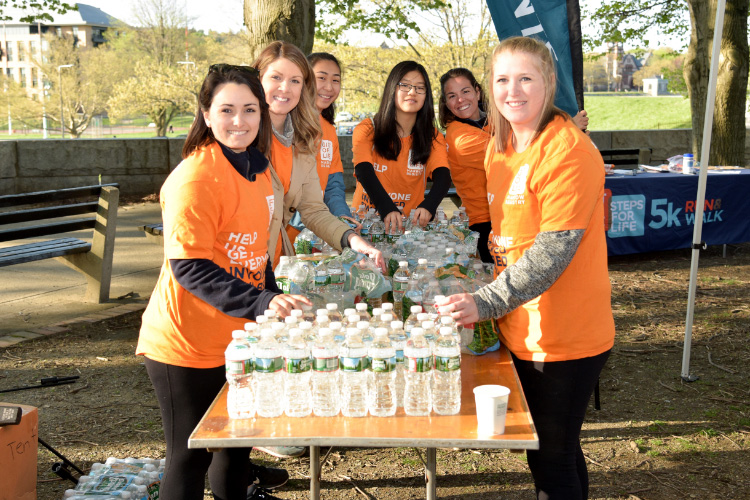







After the collection of peripheral blood stem cells or marrow is complete, the bag of cells is packed in a medical transport box and given to the courier. The box never leaves the courier, who will personally hand deliver it to the transplant center.
The transplant process is simple: the donated cells are infused through an IV into the patient’s blood. The PBSC or marrow cells naturally find their own way into the cavities of the recipient’s bones, and settle in to begin creating new bone marrow, blood cells, and a healthy immune system. This process is called engraftment.
During the engraftment process the patient typically remains in a “clean room,” a sterile room that protects the patient from harmful germs. Without a functioning immune system, the risk of infection is high. The recovery time for each patient varies, depending on many factors, including the type of treatment they are receiving. The transplant center will test the recipient’s blood frequently for indicators that the new marrow is functioning and producing new cells. The first sign that engraftment is successful is usually an increase in neutrophils, a type of white blood cells, which can start to appear after 10 to 20 days. Platelet counts usually begin to rise in the weeks after neutrophil engraftment occurs.
Occasionally, the recipient may need additional transfusions of white blood cells or platelets. A donor leukocyte infusion or DLI is where the donor is asked for a white blood cell-only donation to help the patient's recovery process. Growth factors may be administered to the recipient as well, to help speed the engraftment process.
Should the recipient experience graft vs. host disease, where the transplanted cells see the recipient’s cells as possible enemies, treatment is given to control the condition.
Once the patient’s immune system has recovered sufficiently, he or she can return home and gradually resume normal activities and go on with life. Every patient is different, and so is their recovery.
Gift of Life may receive periodic updates on the recipient’s recovery, and if so, will share this information with the donor.
Under current regulations in the United States, the donor and recipient may exchange anonymous letters for the first year. These are transmitted by the donor registry through the transplant center; no direct contact is permitted and any identifying information in the letters is removed. Both the donor and recipient may participate in correspondence, but neither is obligated to do so. If the required one-year waiting period has passed and both the donor and recipient are agreeable to learning each other’s identities, this information can be shared by the donor registry and the transplant center, and you are then free to contact each other. Remember, both parties must agree for the information exchange to take place.
If your transplant recipient is outside the United States, they are subject to different rules, and waiting periods and introduction regulations differ from country to country. Some countries only allow the exchange of anonymous letters, and a few do not permit any contact.
Whether you ever meet your recipient or not, you are a hero for having stepped forward and saved the life of another human being. This is an incredible gift, and means so much not only to that person, but to their family, friends, co-workers and community. Thank you for donating. Every donor is a hero to us!

Whether you ever meet your recipient or not, you are a hero for having stepped forward and saved the life of another human being. This is an incredible gift, and means so much not only to that person, but to their family, friends, co-workers and community. Thank you for donating. Every donor is a hero to us!
Campus Ambassador Program: If you are a college student, you may want to become a Campus Ambassador for Gift of Life. This is an on-campus internship to run cheek swab drives and give your peers the opportunity to save a life.
Coaching New Donors: Now that you have been through the experience, you can help other prospective donors by answering their questions or coaching them through their donation. Let your Gift of Life transplant coordinator know if you are willing to talk to new donors about what to expect.
Sharing Your Story: We welcome you to tell your story and hope that you will feel comfortable sharing your personal experience. We may interview you to write a story about you for our main website, and you may wish to contact the news media in your area about your donation story. If you’d like support from Gift of Life in sharing your story with your community, we are here to help you. We can also provide information, photos, statistics and other supplemental materials to the media.
Running Drives: Help us find more lifesaving donors by running donor recruitment drives. We have all the tools you need to run drives in your community.
Fundraising: It costs $60 to process and add each donor to the registry. As Gift of Life receives no government funding, these costs are entirely paid for through the contributions of our supporters. Anyone can set up a fundraising drive to benefit Gift of Life.
Social Media: Social media is a powerful tool for educating others. Follow us on Facebook, Instagram, Twitter and LinkedIn, TikTok, and invite your friends to do the same.
Donor Circles: Donor Circles allow anyone to create a team fundraising page on Gift of Life’s website and invite a group of financial supporters to join your efforts. Donor Circles track activity in real time, including the numbers of potential donors sponsored, matches made, and transplants facilitated, as well as offering social media tools.